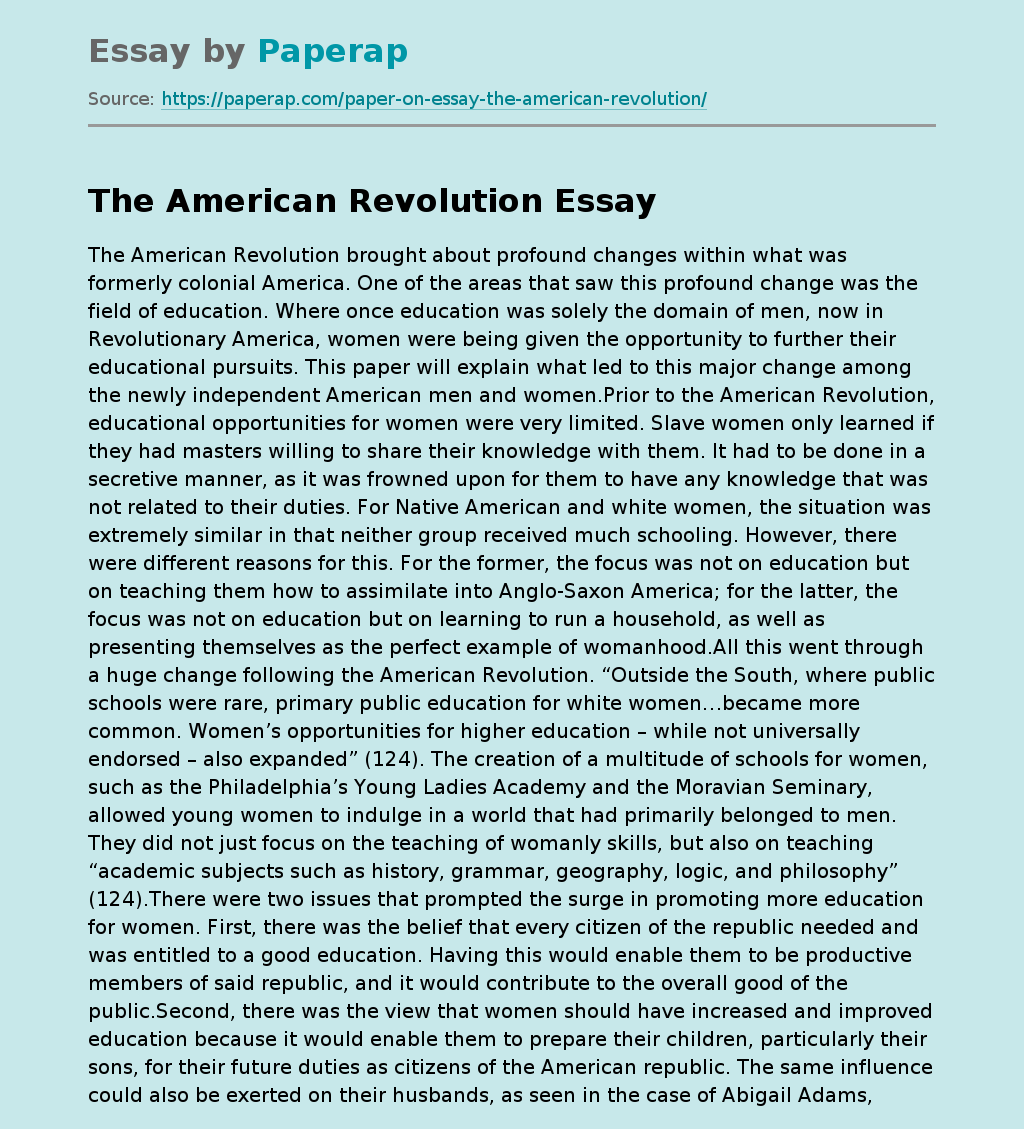The American Revolution
The following sample essay on “The American Revolution”: it brought about profound changes within what was formerly colonial America. One of the areas that saw this profound change was the field of education. Where once education was solely the domain of men, now in Revolutionary America, women were being given the opportunity to further their educational pursuits. This paper will explain what led to this major change among the newly independent American men and women.Prior to the American Revolution, educational opportunities for women were very limited.
Slave women only learned if they had masters willing to share their knowledge with them. It had to be done in a secretive manner, as it was frowned upon for them to have any knowledge that was not related to their duties. For Native American and white women, the situation was extremely similar in that neither group received much schooling. However, there were different reasons for this. For the former, the focus was not on education but on teaching them how to assimilate into Anglo-Saxon America; for the latter, the focus was not on education but on learning to run a household, as well as presenting themselves as the perfect example of womanhood.
All this went through a huge change following the American Revolution. “Outside the South, where public schools were rare, primary public education for white women…became more common. Women’s opportunities for higher education – while not universally endorsed – also expanded” (124). The creation of a multitude of schools for women, such as the Philadelphia’s Young Ladies Academy and the Moravian Seminary, allowed young women to indulge in a world that had primarily belonged to men.
They did not just focus on the teaching of womanly skills, but also on teaching “academic subjects such as history, grammar, geography, logic, and philosophy” (124).There were two issues that prompted the surge in promoting more education for women. First, there was the belief that every citizen of the republic needed and was entitled to a good education. Having this would enable them to be productive members of said republic, and it would contribute to the overall good of the public.Second, there was the view that women should have increased and improved education because it would enable them to prepare their children, particularly their sons, for their future duties as citizens of the American republic. The same influence could also be exerted on their husbands, as seen in the case of Abigail Adams, who played an integral role in her husband John Adams’ political career. Her influence could also be seen in her son, John Quincy Adams, who also had an illustrious political career.Within the reading are two excerpts that discuss two points of view concerning education for women. The first focuses on Dr. Benjamin Rush, “the preeminent physician and medical teacher of the revolutionary era” (124). In an essay entitled Thoughts upon Female Education, Rush promotes a more intense curriculum for female students. However, he makes it clear that women should not attempt to pursue more advanced study, as that is best left to men.
The second focuses on Judith Sargent Murray. While not as famous as Rush, she was an accomplished writer and was an early advocate in the women’s rights movement. Her take on why women should receive more education is an interesting one. While Rush promoted education for women because it would enable them to be better wives and mothers, as well as better influence their husbands and sons, Murray believed it was beneficial for women to be educated because it would promote independence.However, there was a drawback to this situation. In spite of the realization that women should and did deserve the opportunity to learn, there were still those who felt limits should be in place. Even those considered progressive, for example Dr. Benjamin Rush, placed limitations on how far women could go in terms of education. In his essay, Thoughts upon Female Education, Rush presents a progressive attitude towards education for women. Yet, he also felt that it was not wise to encourage a woman to pursue advanced study in fields such as “mathematics, natural philosophy, Latin, or Greek” (125) as they were subjects better left to male study. The same can be seen in Murray as well, as she was like most reformers – including Rush – in that she believed “that most women would marry and have children and that women’s improved education would make them better wives and virtuous Republican Mothers” (127).Clearly, this issue – as most issues relating to women and equality in general do – stirred up a great deal of mixed feelings. While many seemed to promote the concept of better education for women, they were willing to go only so far. This invisible roadblock existed due to a fear that an overly educated woman would never fulfill what was seen as the natural role of women: to marry and have children. It was not easily accepted by Revolutionary men or women that a female could be highly educated, yet fulfill her traditional duties of wife and mother.In the end, women of all races, classes, and religions – to a certain extent – were able to improve their educational status following the American Revolution. However, not all were able to actually utilize their increased knowledge in a productive manner. It would be centuries before women would again have the opportunity to gain higher education without risking their femininity.
The American Revolution. (2019, Jun 20). Retrieved from https://paperap.com/paper-on-essay-the-american-revolution/

